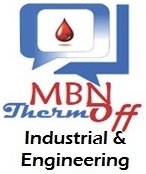Thermal Insulation Services Division
Basis of Operation. How does it work?
Firstly, the thermal coefficient of MBN ThermOFF thermal insulation coating is 0.001…0.0015W/m*С˚. UNBELIEVABLE! Because the thermal conductivity coefficient of air is 23 times higher!
How can the thermal conductivity rate be so low? Isn’t this defying physics?
 Not really! Physics law states that nothing can move by conduction through a vacuum, since it represents an absence of matter. In effect we have a miniature thermos bottle. A microscopic hollow vacuum sphere that resists thermal conductivity and reduces the transfer of heat.
Not really! Physics law states that nothing can move by conduction through a vacuum, since it represents an absence of matter. In effect we have a miniature thermos bottle. A microscopic hollow vacuum sphere that resists thermal conductivity and reduces the transfer of heat.
ThermOFF’smicrosphere’s are devoid of spaces and gas as they have been removed through a special process, thereby creating a vacuum. When mixed into paint, the painted surface will crystallize into a tightly packed reflective film that will effectively reflect, refract and dissipate heat radiation.
It is known from knowledge of physics that air is the best thermal insulator on Earth because air has the least density and the lowest thermal conductivity coefficient (thermal conductivity of the air is 0.023...026 W/m*С˚) depending on ambient temperature.
But if the air is rarefied so that its condition is close to vacuum, its thermal conductivity increases sufficiently. Precisely this condition of the air is reached inside ceramic microspheres.
Due to high efficiency of materials in respect of both heat transmission methods at the same time, MBN ThermOFF liquid ceramic thermal insulation coatings have thermal conductivity coefficient much lower than that of air. Thermal conductivity coefficient of MBN ThermOFF liquid thermal insulator is 0.0011 W/m*С˚, which is 23 times less than thermal conductivity coefficient of the air.
History of Thermal Ceramic Barrier Research and Development
Since the 1970s NASA and the Soviet Union’s SSP worked on creating exterior thermal barriers for the reusable Space Shuttle and Buran Respectively for earth re-entry.
Ceramic is a historically known material that can temperatures in excess of +1000С. The only problem with ceramic however is its brittleness and the inability to ‘’wrap’’ it around curved surfaces. Although mounting ceramic sheets on the space shuttle was possible, it turned out to be unfeasible for commercial applications and was shelved until more research and development could be conducted.
After Thermal barrier technology wad declassified to the public and Industry in the 90’s, scientists started research and development into technology for producing ceramic vacuum microspheres. In the course of time such liquid thermal insulation materials became widely used in the USA and other countries of the world.
Specialists at Innovative Technologies companies, cooperating with leading academic institutes on both sides of the Atlantic have been developing advancing liquid ceramic thermal insulators and implementing this most progressive technology into construction, industry and heat power engineering for some time now. These applications are the future of energy saving technologies.
Having implemented thermal insulation actions at tens of living and industrial buildings, facilities of fuel and energy complex, petrol industry and many others, we can certainly declare that liquid ceramic thermal insulators are the future of energy saving technologies.

MBN ThermOFF in the Construction Industry
*Click any Icon to be Redirected
Liquid thermal insulation coating series MBN ThermOFF are developed for various areas of human activity and eco protection. During the construction and renovation phase of buildings and structures, thermal insulation is a definite must, especially in times where energy conservation is a priority. With additional fireproofing properties, they are the ideal and best solutions for residential and industrial building as well.
When applying MBN ThermOFF to reconstructed structures, you do not create additional burden on the foundation design as well as the construction. The structures will not only be able to withstand changes in temperature and humidity, but also from UV light and other damaging environmental effects .
Among other benefits, MBN ThermOFF has excellent water vapor permeability, hence during wall construction, insulated cover MBN ThermOFF does not accumulate moisture from the room and therefore prevents hazardous material to build up, such as mold.
MBN ThermOFF also has waterproofing properties; therefore coated surfaces will not become wet from rain and moisture.







